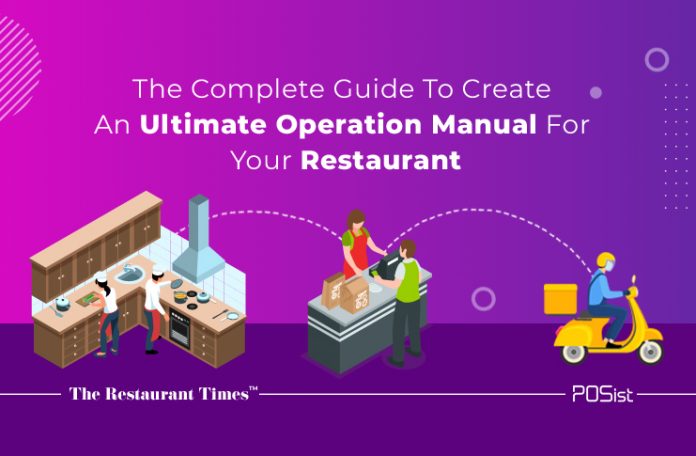Restaurant operation manuals are the spine of restaurant businesses. They include a set of important documents, guidelines, and other information that restaurant managers and staff should be aware of. The operation manual for restaurant also provides guidelines to new restaurant employees and interns. It helps everyone in the restaurant – from the owner to the staff – to be self-reliant. They enable restaurants to maintain uniformity and consistency in terms of maintenance and service delivery, across all outlets.
Being a restaurant operator, one should be aware of how to write a restaurant operation manual such that it streamlines operations and boosts growth. One should have good written communication skills and be attentive to details so that the manual is easy for restaurant employees across departments to understand. One should also include potential emergency situations like fire, natural disaster, etc. when writing the manual. In case you are just getting started, the task of writing the restaurant manual can be outsourced too.
6 Stellar Tips To Create A Perfect Operation Manual For Restaurant
When operating a restaurant, management teams need to realize how important a precise, well-designed operational manual is for their business. The ideal manual is one that’s very detailed, communicates policies and procedures clearly, and is relevant to the job role of every employee.
Here are some best practices one should keep in mind when writing a restaurant operation manual:
1. Create Sections And Subsections And Number Them
A restaurant manual should have different sections and subsections to explain every point clearly. Everything condensed into a single paragraph can be cumbersome to read and understand and can also create confusion. Hence, to keep every point clear and crisp, the manual should be organized into sections and subsections with proper numbering.
2. Use A Word Processor Program
Instead of writing by hand, it is advisable to use word processor software to design the operation manual for your restaurant. Even though the hard copy of the manual is supposed to be kept in the restaurant, an online copy can make future modifications easier.
3. Use Checklists
Checklists are used to deconstruct a complex task into smaller sub-tasks. They are also used to ensure that every item a restaurant might need is taken care of. Checklists are also helpful in step-by-step learning, thereby assisting new trainees in learning about the restaurant operations faster. They are also essential to manage the daily operational tasks of restaurants.
4. Easy-To-Read And Detailed Instructions
The vocabulary used in the manual should be reader-friendly so that it is easier for employees to understand and incorporate the rules into their daily routines. Also, the points should be adequately explained to eliminate any cause for confusion.
5. Provide Real-Life Examples And Situations
Real-life examples can help employees relate to the rules and regulations faster and better. It can also help improve process adherence and minimize conflict between different departments. Real-life situations could also reduce reaction time during emergencies.
6. Give Visual Aids
Research has proven that visual content can help explain concepts better than text. Try adding visual aids in your manual for faster and easier learning.
What Topics Should An Operation Manual For Restaurant Include?
Managing the front-of-the-house and back-of-the-house operations simultaneously can be tricky, especially during peak hours. Thus, a restaurant manual should contain information regarding every process and procedure that forms a part of routine restaurant operations.
Let us have a look at the sections that should be included while creating an operational manual for restaurants.
1. Introduction
The Introduction is the first and a crucial section in the manual. This section is important to help employees understand their individual roles and responsibilities and the common goal for the business as a whole. Following are a few points that should be included in the “introduction” section of the manual:
- A brief introduction of the restaurant and its day-to-day operations.
- The agenda and basic norms of the restaurant. The manual should also include new and modified COVID-19 norms.
- The objectives and long-term goals of the restaurant.
- The opening and closing schedules of the restaurant.
2. Restaurant Staff Hierarchy
It is vital for the employees, especially new hires, to understand the restaurant’s management structure and their individual roles. Employees should be aware of who is responsible for what task so that communication becomes easier and restaurant operations are carried out seamlessly.
Making a visual top-to-bottom flowchart depicting the management hierarchy is a must for any restaurant operations manual. The flowchart should consist of all the job titles of the restaurant to give staff an idea about who to report to, and who is in charge of what. Dividing them into lower, middle and upper levels for easy reference is also recommended. Of course, the names will have to be updated every time someone is hired.
3. Job Descriptions
Job descriptions of each role should always be added while creating an operational manual for the restaurant. This section will explain the must-have skills to the employees and help them function well and deliver better results.
Detailed job descriptions assist the staff to understand their roles better and realize their responsibilities within the restaurant. It helps employees develop an appreciation for other employees’ responsibilities, creating a sense of harmony and team spirit. This can make restaurant operations smooth and efficient.
4. Contact Details
Providing contact information for all employees can save a lot of time for everyone. It is always advisable to include the directory of the restaurant staff that consists of their name, designations, job description and contact information. The contact information can be updated as and when required.
Direct communication is very essential for restaurants to prevent delays, which can result in financial losses and impact customer experience. Having verified contact information of managers and employees listed in the manual can thus save a lot of time and effort.

5. Documented Procedures
This is probably the longest and the most crucial section of any restaurant operations manual. A complete list of all types of procedures can help the staff to learn and perform different tasks sequentially and also to understand what to do in peculiar situations. Given below are some of the procedures that should be listed in the manual.
- Kitchen Procedures: Kitchen procedures are helpful to illustrate to the employees how to work in the kitchen. The basic rules and health and safety norms to be taken care of in the kitchen are included in this section.
- Dining Room Procedures: Dining room procedures relate to the code of conduct to be followed in the restaurant’s dining space. For example, how to interact with the customers, wait, greet, and see them off – every rule is included in this section.
- Hiring Procedures: As the name suggests, hiring procedures take care of the process followed while hiring for the restaurant staff and management. This section provides hiring managers with step-by-step hiring guidelines based on different role requirements, like waiters, chefs, managers, etc.
- Opening/Closing Procedures: These procedures are meant to illustrate the steps to be followed after opening the restaurant in the morning and before closing it at night.
- Emergency Procedures: Emergency procedures cover all the scenarios that could potentially cause damage to the property or endanger the staff. These procedures recommend steps to handle restaurant-related emergencies, like a fire.
- Reservation Handling Procedures: From making reservations for birthdays, corporate parties or weddings, to conducting the event successfully, this section throws light on how to manage clients effectively and garner good reviews from them.
- Service Procedures: Equipment malfunctions are common in a restaurant kitchen. Servicing procedures help the staff to know exactly what to do in such situations.
- Technology Procedures: Technology tools like POS and workforce management systems are being introduced rapidly in restaurants, and the staff needs to be trained to handle it. The technology section can be used to train employees in the use of such platforms.
- Cleaning Procedures: Cleaning procedures familiarize the staff with the steps to follow to keep every nook and corner of the restaurant neat and clean. This section is important, especially in the times of coronavirus.
There are innumerable benefits that an operations manual can provide to restaurants. Creating a diverse and efficient operation manual gives the restaurants an edge over their competitors by streamlining operations and improving ROI.
Follow this guide to create a customized operations manual for your restaurant and boost the efficiency and growth of your restaurant.


















